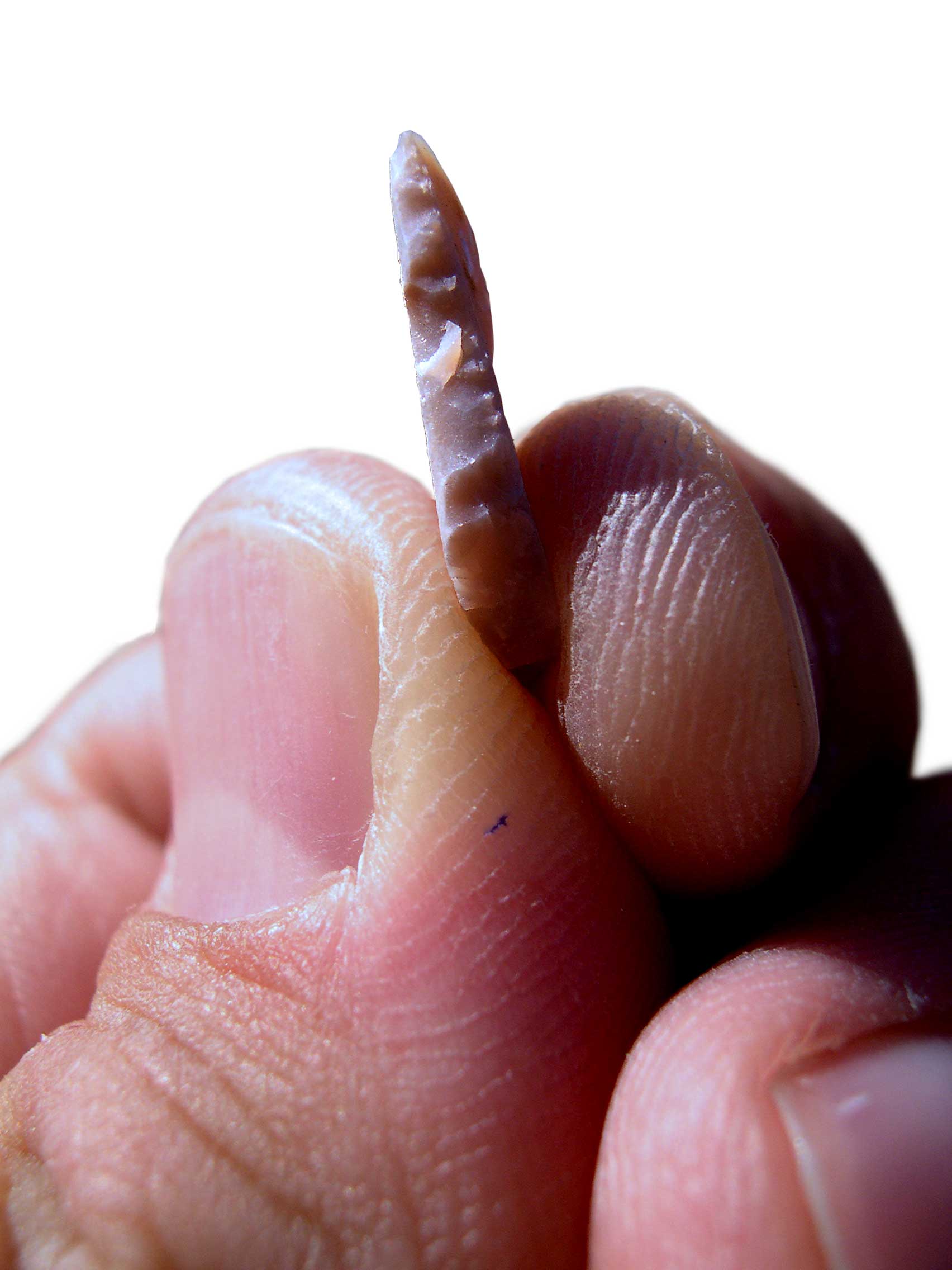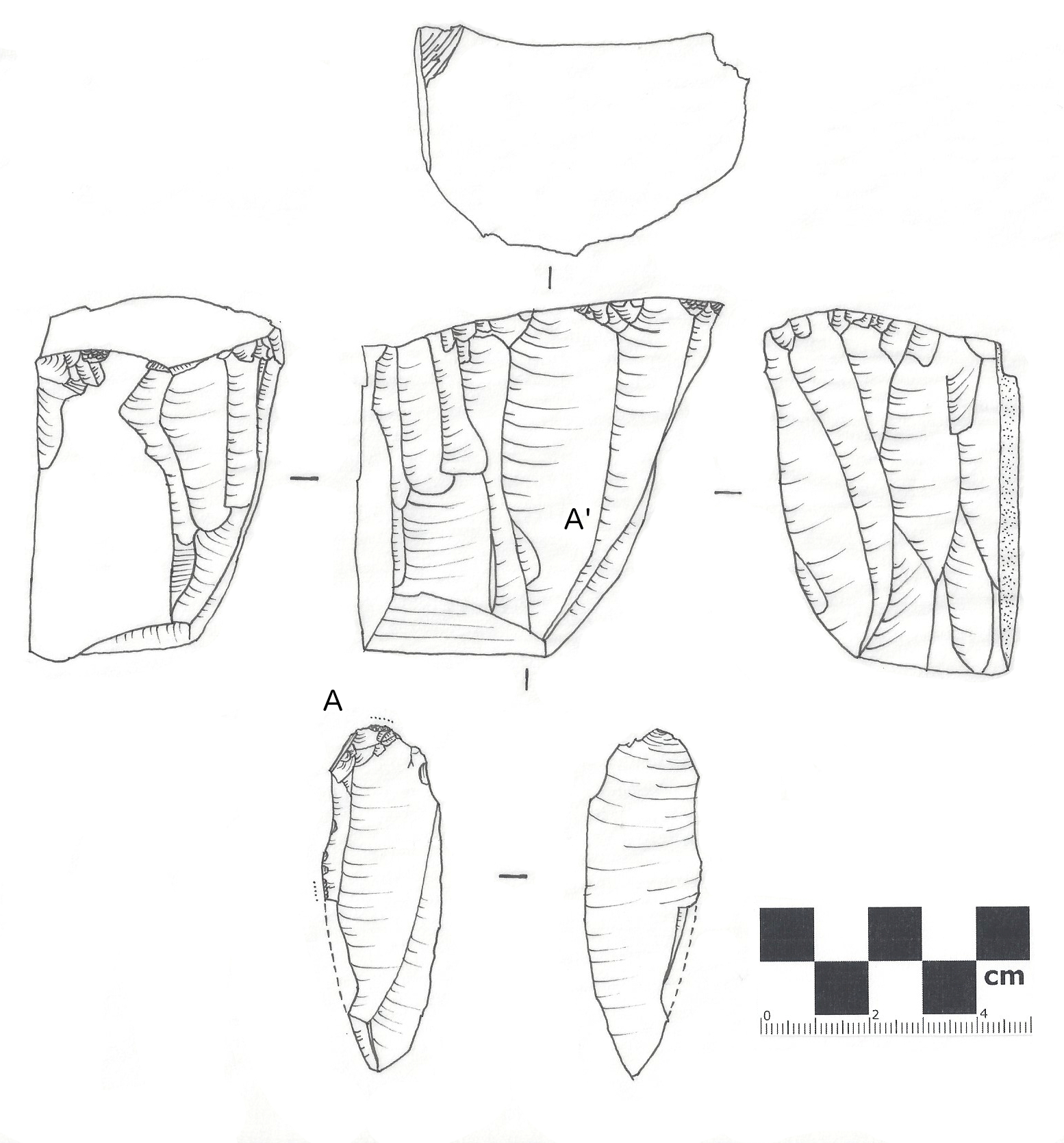|
Microburin
A microburin is a characteristic waste product from manufacture of lithic tools — sometimes confused with an authentic burin — which is characteristic of the Mesolithic, but which has been recorded from the end of the Upper Paleolithic until the Chalcolithic. This type of lithic artifact was first named by Henri Breuil who defined it as "a type of angular, smooth, with a terminal retouch in the form of a small notch". Breuil initially thought that the microburins had a functional use as a type of microlithic burin. However, he later came to realize that the manufacturing technique was different from that of the burin and that they could be waste products from the manufacture of microliths, but they may have occasionally been reused for a useful purpose, which is expected for parsimonious lithic resource exploitation A microburin is a fragment of a lithic flake, or more precisely, of a lithic blade, that shows on its upper face the beginnings of a notch terminating in an obliqu ... [...More Info...] [...Related Items...] OR: [Wikipedia] [Google] [Baidu] |
Microliths
A microlith is a small stone tool usually made of flint or chert and typically a centimetre or so in length and half a centimetre wide. They were made by humans from around 35,000 to 3,000 years ago, across Europe, Africa, Asia and Australia. The microliths were used in spear points and arrowheads. Microliths are produced from either a small blade ( microblade) or a larger blade-like piece of flint by abrupt or truncated retouching, which leaves a very typical piece of waste, called a microburin. The microliths themselves are sufficiently worked so as to be distinguishable from workshop waste or accidents. Two families of microliths are usually defined: laminar and geometric. An assemblage of microliths can be used to date an archeological site. Laminar microliths are slightly larger, and are associated with the end of the Upper Paleolithic and the beginning of the Epipaleolithic era; geometric microliths are characteristic of the Mesolithic and the Neolithic. Geometric micr ... [...More Info...] [...Related Items...] OR: [Wikipedia] [Google] [Baidu] |
Microburin Technique
The microburin technique is a special procedure for cutting up lithic blades which yields fragments that can be used in the manufacture of utensils. The usable fragments are basically geometric microliths. This technique has been recorded through the Old World, from at least the Mesolithic. It has also been recorded from the later phases of the Upper Paleolithic, as triangular and trapeze shaped microliths have been found from the end of the French Magdalenian although they are very rare. The microburin blow technique has not been found, at present, in the New World. The technique consists of taking a blade (a flake can also be used) and placing its upper end against a support with a sharp edge (as occurs in the use of an anvil). A notch is then made and enlarged using light blows or by pressing the edge of the piece against the angled edge of the support. The notch is enlarged until the lithic blade snaps with a gentle but positive action ( flection). If the technique is carried ... [...More Info...] [...Related Items...] OR: [Wikipedia] [Google] [Baidu] |
Henri Breuil
Henri Édouard Prosper Breuil (28 February 1877 – 14 August 1961), often referred to as Abbé Breuil, was a French Catholic priest, archaeologist, anthropologist, ethnologist and geologist. He is noted for his studies of cave art in the Somme and Dordogne valleys as well as in Spain, Portugal, Italy, Ireland, China with Teilhard de Chardin, Ethiopia, British Somali Coast Protectorate, and especially Southern Africa. Life Breuil was born at Mortain, Manche, France, and was the son of Albert Breuil, magistrate, and Lucie Morio De L'Isle. He received his education at the Seminary of St. Sulpice and the Sorbonne and was ordained in 1900, and was also given permission to pursue his research interests. He was a man of deep religious faith and learning. In 1904 Breuil had recognised that a pair of 13,000-year-old carvings of reindeer at the British Museum were in fact one composition. {{DEFAULTSORT:Breuil, Henri 1877 births 1961 deaths Catholic clergy scientists French ... [...More Info...] [...Related Items...] OR: [Wikipedia] [Google] [Baidu] |
Calcolithic
The Copper Age, also called the Chalcolithic (; from grc-gre, χαλκός ''khalkós'', "copper" and ''líthos'', "stone") or (A)eneolithic (from Latin ''aeneus'' "of copper"), is an archaeological period characterized by regular human manipulation of copper, but prior to the discovery of bronze alloys. Modern researchers consider the period as a subset of the broader Neolithic, but earlier scholars defined it as a transitional period between the Neolithic and the Bronze Age. The archaeological site of Belovode, on Rudnik mountain in Serbia, has the world's oldest securely dated evidence of copper smelting at high temperature, from (7000 BP). The transition from Copper Age to Bronze Age in Europe occurred between the late 5th and the late In the Ancient Near East the Copper Age covered about the same period, beginning in the late and lasting for about a millennium before it gave rise to the Early Bronze Age. Terminology The multiple names result from mu ... [...More Info...] [...Related Items...] OR: [Wikipedia] [Google] [Baidu] |
Lithic Flake
In archaeology, a lithic flake is a "portion of rock removed from an objective piece by percussion or pressure,"Andrefsky, W. (2005) ''Lithics: Macroscopic Approaches to Analysis''. 2d Ed. Cambridge, Cambridge University Press and may also be referred to as simply a ''flake'', or collectively as debitage. The objective piece, or the rock being reduced by the removal of flakes, is known as a core.Andrefsky, W. (2005) ''Lithics: Macroscopic Approaches to Analysis''. 2d Ed. Cambridge, Cambridge University Press Once the proper tool stone has been selected, a percussor or pressure flaker (e.g., an antler tine) is used to direct a sharp blow, or apply sufficient force, respectively, to the surface of the stone, often on the edge of the piece. The energy of this blow propagates through the material, often ( but not always) producing a Hertzian cone of force which causes the rock to fracture in a controllable fashion. Since cores are often struck on an edge with a suitable angle (<90� ... [...More Info...] [...Related Items...] OR: [Wikipedia] [Google] [Baidu] |
Lithic Blade
In archaeology, a blade is a type of stone tool created by striking a long narrow flake from a stone core. This process of reducing the stone and producing the blades is called lithic reduction. Archaeologists use this process of flintknapping to analyze blades and observe their technological uses for historical purposes. Blades are defined as being flakes that are at least twice as long as they are wide and that have parallel or subparallel sides and at least two ridges on the dorsal (outer) side. Blade cores appear and are different from regular flaking cores, as each core's conchoidal nature is suited for different types of flaking. Blades are created using stones that have a cryptocrystalline structure and easily be fractured into a smooth piece without fracturing. Blades became the favored technology of the Upper Palaeolithic era, although they are occasionally found in earlier periods. Different techniques are also required for blade creation; a soft punch or hammerstone ... [...More Info...] [...Related Items...] OR: [Wikipedia] [Google] [Baidu] |
Burin (lithic Flake)
Burin from the Upper Paleolithic (Gravettian) (ca. 29,000–22,000 BP) In the field of lithic reduction, a burin (from the French ''burin'', meaning "cold chisel" or modern engraving burin) is a type of handheld lithic flake with a chisel-like edge which prehistoric humans used for engraving or for carving wood or bone. In archaeology, burin use is often associated with "burin spalls", which are a form of debitage created when toolmakers strike a small flake obliquely from the edge of the burin flake in order to form the graving edge. Documented use left, 180px, Carinated "burin"/microblade core with multiple facets Standardized burin usage is typical of the Middle Paleolithic and Upper Palaeolithic cultures in Europe, but archaeologists have also identified them in North American cultural assemblages, and in his book ''Early Man in China'', Jia Lanpo of Beijing University lists dihedral burins and burins for truncation among artifacts uncovered along the banks of the Li ... [...More Info...] [...Related Items...] OR: [Wikipedia] [Google] [Baidu] |
Sahara
, photo = Sahara real color.jpg , photo_caption = The Sahara taken by Apollo 17 astronauts, 1972 , map = , map_image = , location = , country = , country1 = , country2 = , country3 = , country4 = , country5 = , country6 = , country7 = , country8 = , country9 = , country10 = ( disputed) , region = , state = , district = , city = , relief = , label = , label_position = , coordinates = , coordinates_ref = , elevation = , elevation_m = , elevation_ft = , elevation_ref = , length = , length_mi = , length_km = 4,800 , length_orientation = , length_note = , width = , width_mi = , widt ... [...More Info...] [...Related Items...] OR: [Wikipedia] [Google] [Baidu] |
Jacques Tixier
250px, Jacques Tixier Jacques Tixier (1 January 1925 – 3 April 2018) was a French archaeologist and prehistorian notable for his work on prehistory in Qatar, Lebanon, and North Africa. He led the first French archaeological mission to Qatar in 1976. His team, Mission Archéologique Français à Qatar, discovered Al Khor Island that year. He also discovered an archaeological site in Shagra Shaqra ( ar, شقراء) is a town in central Saudi Arabia, The city is located about 190 kilometers north-west of the capital Riyadh. It is a small city which is now growing due to the newly opened Shaqra University. The city is peaceful and we .... Tixier published one of two volumes of the team's findings in 1980, with the second volume being published by his colleague Marie‐Louise Inizan in 1988. References 1925 births 2018 deaths French archaeologists People from Bordeaux {{archaeologist-stub ... [...More Info...] [...Related Items...] OR: [Wikipedia] [Google] [Baidu] |

_Wolf.png)

